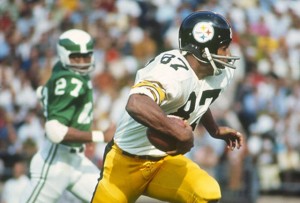Roy Jefferson isn’t well-remembered today, but he was one of the top receivers at the start of the Super Bowl era. Jefferson was a second round pick of both the Steelers and Chargers in 1965, back when the leagues held separate drafts. Jefferson chose to sign with Pittsburgh, and in his second season, he led the NFL with a 24.1 yards per reception average. In 1968, Jefferson led the NFL in receiving yards and scored 11 touchdowns, one behind Paul Warfield for the lead. Jefferson matched his production the next year and was a unanimous first-team All-Pro selection. But for Jefferson, personal glory was the only success he would see in Pittsburgh, as the Steelers went just 7-33-2 from ’67 to ’69.
Jefferson’s 1969 performance was interesting for another reason. He gained 44% of his team’s receiving yards, and since then, only a few other players have reached that mark:
As Steelers fans know, 1969 was a key year in the franchise’s history. It was Chuck Noll’s first season, and his first draft selection was Joe Greene. After finishing with the league’s worst record in 1969, Pittsburgh won the rights to draft Terry Bradshaw. On the field, Jefferson was the best player in Noll’s first season. But that doesn’t mean Noll and Jefferson got along.
The start of the 1970 season was in jeopardy because of a players’ strike. After it was resolved quickly and largely in the owners’ favor, Jefferson publicly expressed his dissatisfaction. Jefferson began flouting Noll’s authority in training camp back in the days when such actions weren’t tolerated. Noll responded by shopping the team’s star player. He got a bite with the Baltimore Colts, who agreed to trade their 1971 fourth round pick and wide receiver Willie Richardson for Jefferson.
As Jefferson would say years later:
“I was considered a rebel… I was the team’s player rep, and they thought I was not a good guy to keep around. I think they thought I had too much clout with the players….I did a lot of things in the community…I never was arrested or involved in any kind of illegal activity. I never got into the kind of trouble you hear about guys getting into today. But back then, athletes weren’t supposed to speak out. We were supposed to listen. I was very outspoken, and that made me very unpopular with Chuck Noll.”

Jefferson may not have been the greatest blocking WR in the history of the universe, but he's the only Steeler to lead the league in receiving yards since 1933.
With the 4th round pick Pittsburgh received from Baltimore for Jefferson, the Steelers hit gold with Dwight White, a defensive end out of Texas A&M-Commerce who would start for eight seasons in Pittsburgh. White was a two-time Pro Bowler who would contribute to four Super Bowl champions.
But it would be hard to justify the trade based on the success of White. Pittsburgh traded a dominant wide receiver in his prime for, in essence, a fourth and a fifth round pick. That fifth round pick was used to select Ralph Anderson, a safety out of West Texas A&M. Anderson, like most fifth round picks, did not pan out. He was a reserve as a rookie but started in 1972. Then, in training camp before the 1973 season, Noll sent Anderson to New England for a fourth round pick in the ’74 draft. Owning the 82nd pick in that draft from the Patriots, Pittsburgh then selected Alabama A&M’s John Stallworth. And that’s how the Steelers traded a star wide receiver and won four Super Bowls.
Things didn’t turn out too badly for Jefferson, either. In 1970, he led the Colts in receiving yards and earned a Super Bowl ring. Jefferson and management didn’t get along any better in Baltimore, however, and he was traded to the Redskins after his one year with the Colts. Washington sent a 1973 first round pick and Texas rookie Cotton Speyrer to Baltimore for Jefferson, who played well in five seasons in Washington. Jefferson led the team in receiving yards and made the Pro Bowl in 1971 and helped the Skins reach the Super Bowl in 1972.
